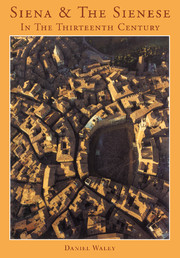Book contents
- Frontmatter
- Contents
- List of illustrations
- List of tables
- Preface
- Acknowledgements
- Glossary
- Abbreviations
- Chronology of principal political events and developments
- 1 Siena
- 1 Setting
- 2 People
- 3 Institutions
- 4 Oligarchy
- 5 Problems
- 6 Religion
- 7 Assumptions
- 8 Revenue
- 9 Expenditure
- 10 Continuity and change
- General Index
- Index of personal names
- Index of places
- Frontmatter
- Contents
- List of illustrations
- List of tables
- Preface
- Acknowledgements
- Glossary
- Abbreviations
- Chronology of principal political events and developments
- 1 Siena
- 1 Setting
- 2 People
- 3 Institutions
- 4 Oligarchy
- 5 Problems
- 6 Religion
- 7 Assumptions
- 8 Revenue
- 9 Expenditure
- 10 Continuity and change
- General Index
- Index of personal names
- Index of places
Summary
The emphasis of this chapter will be on the relative importance of different forms of revenue and on how Siena's fiscal system affected the citizens. The commune's fiscal institutions and their functioning at this time and later have been depicted very thoroughly in William Bowsky's pioneering The Finance of the Commune of Siena 1287–1355 (1971). The view offered here, less detailed and less institutional, also differs in that it attempts a more general assessment of the commune's fiscal policies and their impact. One feature common to Bowsky's approach and mine is the cautious treatment of quantitative matters, necessitated by the nature of the surviving source material.
Some general points need to be clarified about the commune's fiscality before considering the revenues under the various forms in which they were gathered. The institution central to revenue-collecting activities was the Biccherna and the principal surviving source for the subject is the series of volumes of the Entrata and Uscita (Revenue and Expenditure) of that office which, with some gaps, go back to 1226. From the later thirteenth century, however, the organization of indirect taxation by a separate office (the Gabella) achieved increasing independence, and money received by it is not recorded, or only indirectly reflected, in the Biccherna volumes. It is fundamental that the concept of a ‘budget’ is absent from the philosophy of the medieval communes. Fiscal policy was hand-to-mouth and consisted of a series of reactions to the city's constantly changing financial situation.
- Type
- Chapter
- Information
- Siena and the Sienese in the Thirteenth Century , pp. 168 - 184Publisher: Cambridge University PressPrint publication year: 1991

